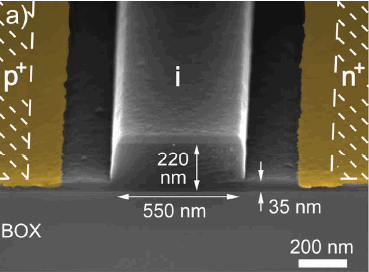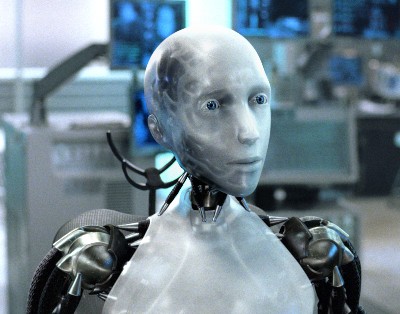
Dynamics

|
Generational Dynamics |
| Forecasting America's Destiny ... and the World's | |
| HOME WEB LOG COUNTRY WIKI COMMENT FORUM DOWNLOADS ABOUT | |
Also, the Japanese are developing robots that play the violin and do other neat things.
Back in 1964, an engineer friend of mine told me this: "Computers can't get much faster. The circuits in today's computers require signals to travel at almost the speed of light, and there is no way to get around that. Thus, computers may get a little faster, but not much faster than they are today."
There was a way around that, of course -- to make the circuits in the computer smaller and smaller. Electricity would still travel around the circuits at the speed of light, but the electricity would have much less distance to travel.
Since the 1960s, computer circuits have been made smaller and smaller by packing more and more tiny transistors onto a silicon chip. More transistors on a chip means shorter distances between chips, which means faster computers.
According to Moore's Law, described in 1965 by Intel co-founder Gordon Moore, the number of transistors on a chip would double every two years, making computers faster and faster.
However, more transistors also mean more heat - a lot more heat. This placed a theoretical limit on Moore's law that it would stop working in the 2010s decade, and computers would no longer get faster.
 |
But now, new "nanophotonic" technology from IBM overcomes the limitations to Moore's law by using light pulses instead of electrical pulses to transmit information. Light pulses generate much less heat, and so much more information can be packed into the same space.
Instead of using copper wire to transmit electrical pulses, the new technology uses "nanophotonic rib waveguide diodes" to transmit light pulses.
The picture above shows one of these rib waveguides. Each one is 550 nm (nanometers) wide. That means that if you took 200 of these waveguides, and placed them side by side, the total width would still less than the width of a human hair.
Within a few years, it will be possible to build supercomputers that are as powerful as the human brain, and then it will be possible to develop computer software that, within a few years, make the computer as intelligent as a human being.
 |
If you saw the the 2004 movie I, Robot, then you may recall that intelligent robots were living side by side with human beings. That was a movie, but the technology will soon become quite real.
At some point, probably some time in the late 2020s, computers will be intelligent enough so that they'll be responsible for their own research and development as necessary to invent new, more powerful versions of themselves.
 |
At this point, known as the Singularity, computers will quickly become so much more intelligent than humans that they'll displace humans as the major "species" on earth. Whether the human race will survive long after 2030 is not known, and is impossible to predict.
However, in the meantime, robots are being designed to do some neat things, especially by the Japanese.
On Thursday, Toyota Motor Co. announced some new home robots that are under development, including one that plays the violin.
Here's a video of the Toyota robots:
Quite honestly, I thought the violin playing was a little scratchy.
(8-Dec-07)
Permanent Link
Receive daily World View columns by e-mail
Donate to Generational Dynamics via PayPal
Web Log Summary - 2016
Web Log Summary - 2015
Web Log Summary - 2014
Web Log Summary - 2013
Web Log Summary - 2012
Web Log Summary - 2011
Web Log Summary - 2010
Web Log Summary - 2009
Web Log Summary - 2008
Web Log Summary - 2007
Web Log Summary - 2006
Web Log Summary - 2005
Web Log Summary - 2004
Web Log - December, 2016
Web Log - November, 2016
Web Log - October, 2016
Web Log - September, 2016
Web Log - August, 2016
Web Log - July, 2016
Web Log - June, 2016
Web Log - May, 2016
Web Log - April, 2016
Web Log - March, 2016
Web Log - February, 2016
Web Log - January, 2016
Web Log - December, 2015
Web Log - November, 2015
Web Log - October, 2015
Web Log - September, 2015
Web Log - August, 2015
Web Log - July, 2015
Web Log - June, 2015
Web Log - May, 2015
Web Log - April, 2015
Web Log - March, 2015
Web Log - February, 2015
Web Log - January, 2015
Web Log - December, 2014
Web Log - November, 2014
Web Log - October, 2014
Web Log - September, 2014
Web Log - August, 2014
Web Log - July, 2014
Web Log - June, 2014
Web Log - May, 2014
Web Log - April, 2014
Web Log - March, 2014
Web Log - February, 2014
Web Log - January, 2014
Web Log - December, 2013
Web Log - November, 2013
Web Log - October, 2013
Web Log - September, 2013
Web Log - August, 2013
Web Log - July, 2013
Web Log - June, 2013
Web Log - May, 2013
Web Log - April, 2013
Web Log - March, 2013
Web Log - February, 2013
Web Log - January, 2013
Web Log - December, 2012
Web Log - November, 2012
Web Log - October, 2012
Web Log - September, 2012
Web Log - August, 2012
Web Log - July, 2012
Web Log - June, 2012
Web Log - May, 2012
Web Log - April, 2012
Web Log - March, 2012
Web Log - February, 2012
Web Log - January, 2012
Web Log - December, 2011
Web Log - November, 2011
Web Log - October, 2011
Web Log - September, 2011
Web Log - August, 2011
Web Log - July, 2011
Web Log - June, 2011
Web Log - May, 2011
Web Log - April, 2011
Web Log - March, 2011
Web Log - February, 2011
Web Log - January, 2011
Web Log - December, 2010
Web Log - November, 2010
Web Log - October, 2010
Web Log - September, 2010
Web Log - August, 2010
Web Log - July, 2010
Web Log - June, 2010
Web Log - May, 2010
Web Log - April, 2010
Web Log - March, 2010
Web Log - February, 2010
Web Log - January, 2010
Web Log - December, 2009
Web Log - November, 2009
Web Log - October, 2009
Web Log - September, 2009
Web Log - August, 2009
Web Log - July, 2009
Web Log - June, 2009
Web Log - May, 2009
Web Log - April, 2009
Web Log - March, 2009
Web Log - February, 2009
Web Log - January, 2009
Web Log - December, 2008
Web Log - November, 2008
Web Log - October, 2008
Web Log - September, 2008
Web Log - August, 2008
Web Log - July, 2008
Web Log - June, 2008
Web Log - May, 2008
Web Log - April, 2008
Web Log - March, 2008
Web Log - February, 2008
Web Log - January, 2008
Web Log - December, 2007
Web Log - November, 2007
Web Log - October, 2007
Web Log - September, 2007
Web Log - August, 2007
Web Log - July, 2007
Web Log - June, 2007
Web Log - May, 2007
Web Log - April, 2007
Web Log - March, 2007
Web Log - February, 2007
Web Log - January, 2007
Web Log - December, 2006
Web Log - November, 2006
Web Log - October, 2006
Web Log - September, 2006
Web Log - August, 2006
Web Log - July, 2006
Web Log - June, 2006
Web Log - May, 2006
Web Log - April, 2006
Web Log - March, 2006
Web Log - February, 2006
Web Log - January, 2006
Web Log - December, 2005
Web Log - November, 2005
Web Log - October, 2005
Web Log - September, 2005
Web Log - August, 2005
Web Log - July, 2005
Web Log - June, 2005
Web Log - May, 2005
Web Log - April, 2005
Web Log - March, 2005
Web Log - February, 2005
Web Log - January, 2005
Web Log - December, 2004
Web Log - November, 2004
Web Log - October, 2004
Web Log - September, 2004
Web Log - August, 2004
Web Log - July, 2004
Web Log - June, 2004